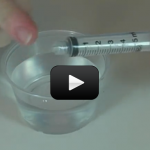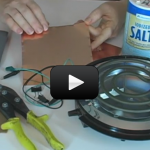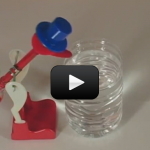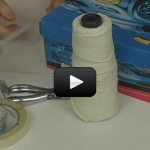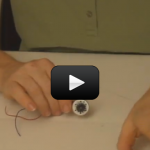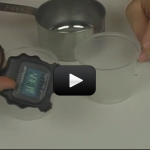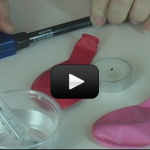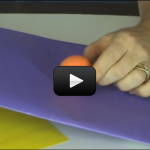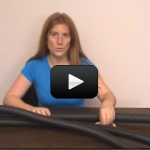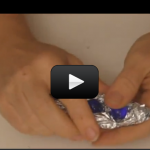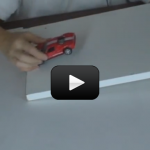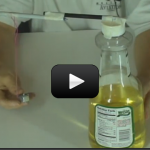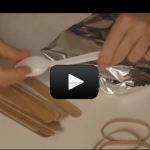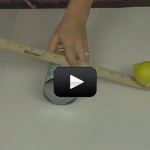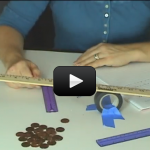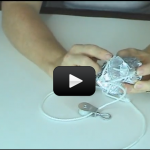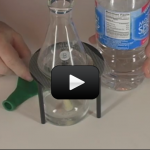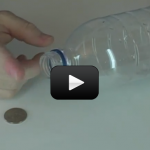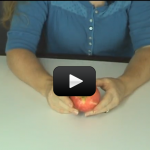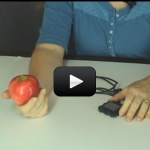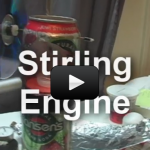Boiling Room Temperature Water
The triple point is where a molecule can be in all three states of matter at the exact same time, all in equilibrium. Imagine having a glass of liquid water happily together with both ice cubes and steam bubbles inside, forever! The ice would never melt, the liquid water would remain the same temperature, and … Continue reading "Boiling Room Temperature Water" |
Solar Battery
This is the kind of energy most people think of when you mention ‘alternative energy’, and for good reason! Without the sun, none of anything you see around you could be here. Plants have known forever how to take the energy and turn it into usable stuff… so why can’t we? The truth is that … Continue reading "Solar Battery" |
Solar Drinking Bird
The Drinking Bird is a classic science toy that dips its head up and down into a glass of water. It’s filled with a liquid called methylene chloride, and the head is covered with red felt that gets wet when it drinks. But how does it work? Is it perpetual motion? Let’s take a look … Continue reading "Solar Drinking Bird" |
Can Wind Be Used as a Source of Energy?
The United States has large reserves of coal, natural gas, and crude oil which is used to make gasoline. However, the United States uses the energy of millions of barrels of crude oil every day, and it must import about half its crude oil from other countries. Burning fossil fuels (oil, coal, gasoline, and natural … Continue reading "Can Wind Be Used as a Source of Energy?" |
Wind Turbine
Believe it or not, most of the electricity you use comes from moving magnets around coils of wire! Wind turbines spin big coils of wire around very powerful magnets (or very powerful magnets around big coils of wire) by capturing the flow. Here’s how it works: when a propeller is placed in a moving fluid … Continue reading "Wind Turbine" |
How Can Water Be Used to Store Heat Energy?
Temperature is a measure of the average hotness of an object. The hotter an object, the higher its temperature. As the temperature is raised, the atoms and molecules in an object move faster. The molecules in hot water move faster than the molecules in cold water. Remember that the heat energy stored in an object … Continue reading "How Can Water Be Used to Store Heat Energy?" |
Fire-Water Balloon
If you’ve ever had a shot, you know how cold your arm feels when the nurse swipes it with a pad of alcohol. What happened there? Well, alcohol is a liquid with a fairly low boiling point. In other words, it goes from liquid to gas at a fairly low temperature. The heat from your … Continue reading "Fire-Water Balloon" |
Inclined Plane
What’s an inclined plane? Jar lids, spiral staircases, light bulbs, and key rings. These are all examples of inclined planes that wind around themselves. Some inclined planes are used to lower and raise things (like a jack or ramp), but they can also used to hold objects together (like jar lids or light bulb threads). Here’s … Continue reading "Inclined Plane" |
Roller Coasters
We're going to build monster roller coasters in your house using just a couple of simple materials. You might have heard how energy cannot be created or destroyed |
Bobsleds
We're going to build monster roller coasters in your house using just a couple of simple materials. You might have heard how energy cannot be created or destroyed |
Go Go GO!!
This is a nit-picky experiment that focuses on the energy transfer of rolling cars. You'll be placing objects and moving them about to gather information about the potential and kinetic energy. |
Mystery Toy
first, and when you're done with the heavy nut from that activity, just use it in this experiment. You can easily create one of these mystery toys out of an old baking powder can, a heavy rock, two paper clips, and a rubber band (at least 3" x 1/4"). It will keep small kids and cats busy for hours. |
Pendulums
This is a very simple yet powerful demonstration that shows how potential energy and kinetic energy transfer from one to the other and back again, over and over. Once you wrap your head around this concept, you'll be well on your way to designing world-class roller coasters. |
Catapults
When you drop a ball, it falls 16 feet the first second you release it. If you throw the ball horizontally, it will also fall 16 feet in the first second, even though it is moving horizontally… it moves both away from you and down toward the ground. |
Human Levers
Levers are classified into three types: first class, second class, or third class. Their class is identified by the location of the load, the force moving the load, and the fulcrum. In this activity, you will learn about the types of levers and then use your body to make each type. |
The SeeSaw
We're going to use everyday objects to build a simple machine and learn how to take data. Sadly, most college students have trouble with these simple steps, so we're getting you a head start here. The most complex science experiments all have these same steps that we're about to do... |
Simple Pulley Experiments
Are you curious about pulleys? This set of experiments will give you a good taste of what pulleys are, how to thread them up, and how you can use them to lift heavy things. |
Balloon Gymnastics
Is it warmer upstairs or downstairs? If you’re thinking warm air rises, then it’s got to be upstairs, right? If you’ve ever stood on a ladder inside your house and compared it to the temperature under the table, you’ve probably felt a difference. So why is it cold on the mountain and warm in the … Continue reading "Balloon Gymnastics" |
Ghost Coin
This spooky idea takes almost no time, requires a dime and a bottle, and has the potential for creating quite a stir in your next magic show. The idea is basically this: when you place a coin on a bottle, it starts dancing around. But there’s more to this trick than meets the scientist’s eye. … Continue reading "Ghost Coin" |
What’s a Joule?
This experiment is for students Grades 9-12. We're going to really get a good feel for energy and power as it shows up in real life. For this experiment.. |
Measuring Power
We're going to practice measuring and calculating real life stuff (because science isn't just in a textbook, is it?) When I taught engineering classes, most students had never analyzed real bridges or tools before - they only worked from the textbook. |
Steamboats
In 1920’s, these were a big hit. They were originally called “Putt Putt Steam Boats”, and were fascinating toys for adults and kids alike. We’ll be making our own version that will chug along for hours. This is a classic demonstration for learning about heat, energy, and how to get your kids to take a … Continue reading "Steamboats" |
Stirling Engine
This project is for advanced students.This Stirling Engine project is a very advanced project that requires skill, patience, and troubleshooting persistence in order to work right. Find yourself a seasoned Do-It-Yourself type of adult (someone who loves to fix things or tinker in the garage) before you start working on this project, or you’ll go … Continue reading "Stirling Engine" |

